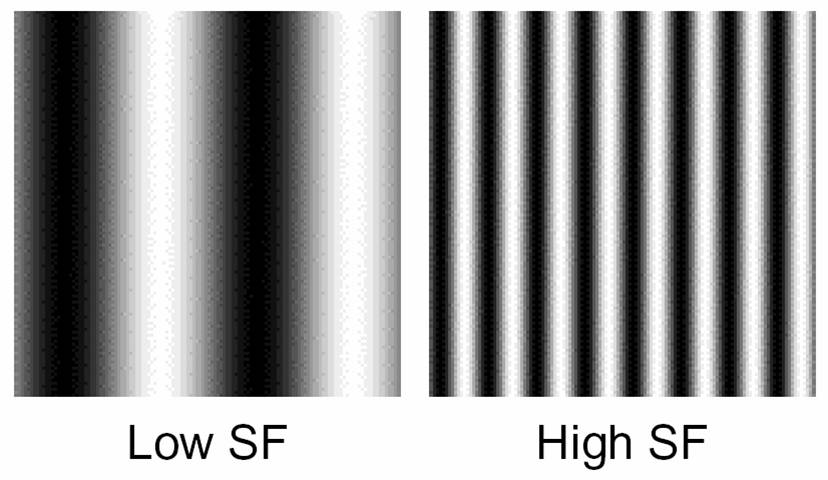written by Xander DuMoulin, Justyn Hermel, Claudia Lampi, and Tate Littlefield

The Albert Einstein and Marilyn Monroe illusion is an image that tricks your brain into seeing two different faces when looking at the picture from different distances. When this image is further away from your face you will see Marilyn Monroe, but as the image gets closer you will see the face of Albert Einstein. This illusion is considered a hybrid image, as it is perceived differently based on the distance it is viewed at. But how is this possible? The illusion heavily relies upon two factors that contribute to our perception of visual information: spatial frequency and contrast sensitivity.
Spatial frequency is defined as “the number of times a pattern repeats in a given unit of space (degree of visual angle)” (Wolf et al., 2021). Manipulating spatial frequencies allows for the creation of hybrid images such that the viewer’s perception is based upon how they are presently interacting with it (Olivia et al. 2017), as exemplified by the Einstein-Monroe illusion. Not only does distance provide a means of interaction – you can also experience the illusion from different angles. If you take the image in front of you and rotate it on the y or x axis, you will see Marilyn just before the image becomes unseeable in contrast to Einstein when it is viewed at a more direct angle. The visual angle is measured by cycles per degree, which is “the angle that would be formed by going from top to bottom (or left to right) of a cycle on the page, passing through the center of the lens, and ending on the retina” (Wolf et al., 2021). The lower the cycles per degree is, the lower the spatial frequency is and vice versa. When spatial frequency is low, it is harder to see a difference between the lines therefore making it blurry and thus we see Monroe, whereas with a high spatial frequency, it is easier to determine where detailed lines are.

Contrast sensitivity is a person’s ability to differentiate between an object and the background behind it (Huang, 2022). It is used to detect differences between similar shades of dark and light colors (EyeQue, 2018). The shading patterns within the Einstein Monroe illusion take advantage of this component in perception. While Einstein’s details are defined, the coloration of wrinkles and hair are not stark in contrast to the shading of Monroe behind him. As such, we lose the wrinkles to the overall shading of the image as we view from afar. This important component of visual functioning is a bit more straightforward than spatial frequency, and is better exemplified on a daily basis. In situations such as heavy fog or high glare, having good contrast sensitivity is necessary for clear vision (Huang, 2022). If a person has poor contrast sensitivity, they may have difficulty driving, walking down steps, reading, and focusing while watching television (EyeQue, 2018).

A widely recognized test for abnormalities in one’s ability to perceive contrast is a Pelli Robson contrast sensitivity chart as shown to the right (EyeQue, 2018). The increasingly lighter colored letters are less and less distinguishable from the white background, just as Einstein’s details are with the Monroe shading.
So how is it possible to have two images in one? The key to the Einstein-Monroe Illusion is the distance between the image and oneself and how this distance influences our perception with relation to spatial frequency and contrast sensitivity. The interplay between these crucial components of visual interpretation is also demonstrated when rotating the image. The highly defined features of Einstein, such as his wrinkles and strands of hair, are easily detected when viewing the image closely. These elements exemplify high spatial frequency details which are only detectable by our eyesight in close proximity (Oliva et al. 2017). Alternatively, the blurry features of Marilyn exemplify low spatial frequency components which our eyesight depends upon from afar (Oliva et al. 2017). The contrast in shading amplifies our perception of Marilyn when distanced. Our mind automatically converts this information into our perception of the image, changing as we interact with it, thus providing us with the comically confusing experience of a two for one deal in a hybrid image.
References
Huang, M. (n.d.). Contrast Sensitivity (Definition, Testing & Treatment). Vision Center. Retrieved April 20, 2022, from https://www.visioncenter.org/refractive-errors/contrast-sensitivity/
Oliva, Aude, and Philippe G. Schyns. “Hybrid Image Illusion.” Oxford Scholarship Online, 2017, https://doi.org/10.1093/acprof:oso/9780199794607.003.0111.
Pelli-Robson Contrast Sensitivity Chart. (n.d.). Denis Pelli. Retrieved April 20, 2022, from https://denispelli.com/pellirobson/index.html
Why is Visual Contrast Sensitivity Important? (2018, August 14). EyeQue. Retrieved April 20, 2022, from https://www.eyeque.com/knowledge-center/why-is-visual-contrast-sensitivity-important/
Wolfe, Jeremy M., et al. Sensation & Perception. Sinauer Associates, an Imprint of Oxford University Press, 2021.